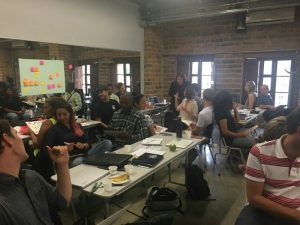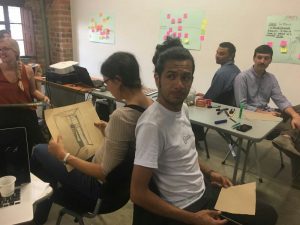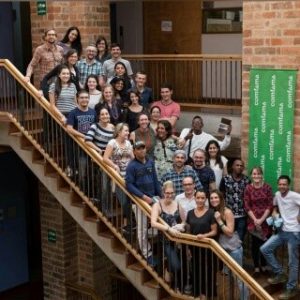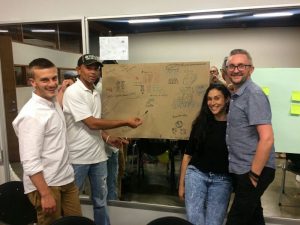J-Term Practica: DPMI Client Project with E2E Foundation in Colombia
Over the J-ter m break, I had the pleasure of doing DPMI with E2E Foundation, run by Teryn Wolfe, a MIIS alum! The workshop was conducted in the beautiful city of Medellin, Colombia, in the ComFama building downtown. ComFama is one of the biggest NGO’s in Colombia that provides training courses and aid to Colombians throughout the country, so the facilities were bright, new and reminded me of studying in San Francisco, to be honest!
m break, I had the pleasure of doing DPMI with E2E Foundation, run by Teryn Wolfe, a MIIS alum! The workshop was conducted in the beautiful city of Medellin, Colombia, in the ComFama building downtown. ComFama is one of the biggest NGO’s in Colombia that provides training courses and aid to Colombians throughout the country, so the facilities were bright, new and reminded me of studying in San Francisco, to be honest!
The following interview is one I conducted with Teryn and her associate  Shelley, a DPMI graduate from a few years back who also helped run the workshop while we were there.
Shelley, a DPMI graduate from a few years back who also helped run the workshop while we were there.
Q: How did E2E start?
Teryn: I initially came to Colombia on a visa after winning a Fulbright. I had idea of the problems in Colombia at the time- social responsibility, financing for development on international level… however, I wasn’t allowed to continue my original study topic, so instead, I worked at the IDEAM- research institute. While I was there teaching and working, I had an idea for E2E. A friend invited me to go to comunas (impoverished towns surrounding the city center in Medellin) and after touring comuna 8, I realized I wanted this idea to turn into a business model, not a non-profit. After I began to get in touch with people in surrounding comunas, E2E evolved naturally, starting with a recycling project called Recuperando Vida. I pitched the idea at start up conference in Bogota, used the money I gained towards market research and worked with nonprofits and social entrepreneurship. I realized that I had a viable model on my hands and so opened E2E in February of 2015 before returning to Washington, DC to work, so we a legal business in the states as well as a consultancy group.
Q: What impact did MIIS have on the creation of E2E?
Teryn: Everything to do with it! DPMI had a big influence- it was easily the most important class I took  at Miis. I was on the IEP/Business and Sustainability track (which is like an MBA) and benefitted so much from learning about corporate social responsibility, environmental policy and business tools that can then be applied to environmental policy. That was a baseline of my education, although the program has changed since then.
at Miis. I was on the IEP/Business and Sustainability track (which is like an MBA) and benefitted so much from learning about corporate social responsibility, environmental policy and business tools that can then be applied to environmental policy. That was a baseline of my education, although the program has changed since then.
Q: How do you get involved with your projects?
Teryn: We sit down and talk to people- we do a needs assessment. We normally work with people who don’t work for organization assumption and the majority of our clients don’t have higher than primary education, so they haven’t seen an application for a consultancy before. This made us realize that we can’t tell our story through an online marketing/sourcing model or have the impact we want to have unless we think outside of the box. Instead, I wait for people to approach me—word of mouth is the most effective way to garner clients. When we went to Rincon del Mar (a coastal town in Colmbia where we are doing impact measure for local company with a recycling project), we went to go meet with a nonprofit there to do work and were informed that they couldn’t help us with the project, instead they told us to meet these 3 men (who ended up attending the DPMI workshop) who ended up meeting me at my hostel and showing me around for 3 day! Everday, more people came from local towns to talk to me about what to change and I knew I had to do something about this. We eventually got a fellowship from a local business center with huge customer database that was a great communication portal for us and who has paid out of pocket for a lot of our needs. It was totally worth the trip and investment.
about what to change and I knew I had to do something about this. We eventually got a fellowship from a local business center with huge customer database that was a great communication portal for us and who has paid out of pocket for a lot of our needs. It was totally worth the trip and investment.
Q: What was the most valuable learning experience from DPMI Monterey that you brought to DPMI Colombia?
Shelley: For this design, we took what worked from DPMI and really thought about what learning objectives would make it worthwhile for students to come all the way from Monterey to Colombia, and what we really focused on was:
- Students work with local companies—this equals real issues,
 real impact.
real impact. - The workshop is part of our strategic line of work– 2 people in the course have their own projects so it was real capacity building—not just academic ‘scenarios’, but you the students helping us develop the communities that these projects are in, which are real world
- The local knowledge from our partners that didn’t exist in DPMI Monterey: our partners know their neighborhoods, their city, and the contexts they live in are so different from what people are experiencing in Monterey or in a made up situation. It broadens the students’ minds and gives them fresh, different perspectives.
- The types of people in the course are so different from what you’d find in Monterey. We had 3 guys from a small coastal town in Colombia, award-winning Colombian floating house designers, ex-combatants who are now fighting for social justice and change in Colombia…you just can’t get that in a California classroom.
The DPMI Colombia workshop came out of our desire to want to use new tools that can be applied to situations where old or standard design thinking tools don’t always fit—dynamic problems that require a lot of tools and heavy thinking that require a massive toolbox to pull from in order to really see the problem. Our end goal was to communicate that you need to choose what tool fits for each project, and in order to do that you need to know all the tools. This workshop was based on DPMI, but we wanted to offer more solutions that are dynamic in a real and changing world and not be so prescriptive!




You must be logged in to post a comment.